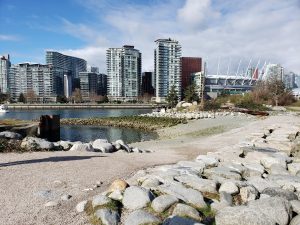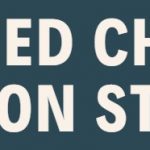Growing up in Vancouver, we often live in a narrative that Vancouver is a nature city surrounded by forests, mountains, and the ocean. This is true, but we often do not realize how much Vancouver has damaged and continues to degrade the environment. When I used to visit False Creek, I thought it was such a beautiful, natural area in Vancouver where wildlife could inhabit. I learned from this field trip that False Creek was filled in to provide space for real estate and how the uniform shoreline is actually not suitable for organisms to grow on. This made me realize that many other ‘nature-esque’ places in Vancouver, may seem natural, but may not be suitable for life to thrive on. I never considered how uniform the shoreline of False Creek was and how it was devoid of intertidal life (figure 1). By comparing the structure of the False Creek shoreline to Habitat Island, I realized how important it was to design structures with nature in mind. It was eye opening to see life growing around the constructed Habitat Island and I hope that more features like this are introduced in other development projects. I also learned how the columns supporting the walkway made for Expo 86 (across from Habitat Island) does not provide adequate habitat for barnacles and mussels. Marc Adams suggested that other structures could be used to support both the walkway and organisms. This made me realize that there are many features that we can change to improve the environment for organisms, but these features often go unnoticed. I hope that more architects, urban planners, developers, and other professions involved with creating new spaces will be aware of their negative and positive impacts, and create spaces that benefit humans and other organisms.


Figure 1. Top to bottom: a) Uniform shores that make up the majority of False Creek. b) Habitat Island built with different sizes of rocks and substrates.
I learned from our discussion with Fraser MacDonald that there is often a poor relationship between fishers and Fisheries and Oceans Canada (DFO). This seems to be a recurring theme for many other issues such as the creation and management of marine protected areas (MPAs). This made me realize the need to bridge these groups together. I also found it frustrating how DFO closed the kelp herring fisheries, which is a sustainable method for harvesting herring roe and is conducted by Indigenous communities. It seems so obvious that the herring fisheries spawning on kelp is the better method, so I do not understand why DFO closed them. DFO’s choice to close these herring fisheries not only affects herring and the environment, but also affects Indigenous communities and their livelihoods. As I am graduating this term, I have been applying and looking for jobs. Learning about how governments often lack good communication with their stakeholders makes me hesitant to work in government as I do not want to contribute to poorly consulted projects. But at the same time, governments have such a large role in our environment, and they can make large and impactful changes, so I am conflicted with these trade-offs. I hope that DFO changes for the better as more meaningful engagement with communities are conducted.
It was refreshing to see to success and potential of the fishing gear retrieval program. I hope that the government continues funding these initiatives and hopefully a retrieval and reuse program will be started as Fraser mentioned. The retrieval and reuse program reminds me of a circular economy model, which will not only help organisms but also reduce carbon emissions from the manufacturing of traps. It is also great to see how NGOs are acting as the bridge between DFO and the fishers in this program. It gives me hope that work is being done to remove ghost fishing gear and I hope to work in the NGO sector in the future as well.
From Fraser’s fishing experience, I was shocked to learn that indentured labour happens in the fishing industry in Canada. I remember hearing about indentured labour in the agriculture field with migrant farmers, but I did not realize that it occurs within other industries and with Canadians as well. This made me think about what other forms of indentured labour occurs in Canada and what the government is doing to prevent this. I hope to continue researching more about this in the future.
During the field trip, I also learned about how many Indigenous people in Abbotsford do not live in the Sumas Lake area because they know that it used to be a lake, but it was drained out to build settlements. It made me think about my home in Richmond, which is a wetland. Knowing that my home should be covered in water makes me scared because what happened to Abbotsford could also happen to my home during my lifetime, if we do not start paying attention to what the world is telling us. Most people, including myself, tend to push off and discount environmental impacts, but after learning about how Indigenous communities recognized this potential consequence early on, it reminds me that we cannot keep pushing the world to its limits; the world will eventually bounce back against human pressure. I hope to continue learning more about Richmond’s wetland habitat and how we can protect the life within it.
All in all, hearing from Marc Adams, Fraser Macdonald, and walking around False Creek made me realize that there are many issues that are not as simple as they seem. It made me realize that I have to dive deeper and think more critically about different issues in order to create meaningful change for the world.


